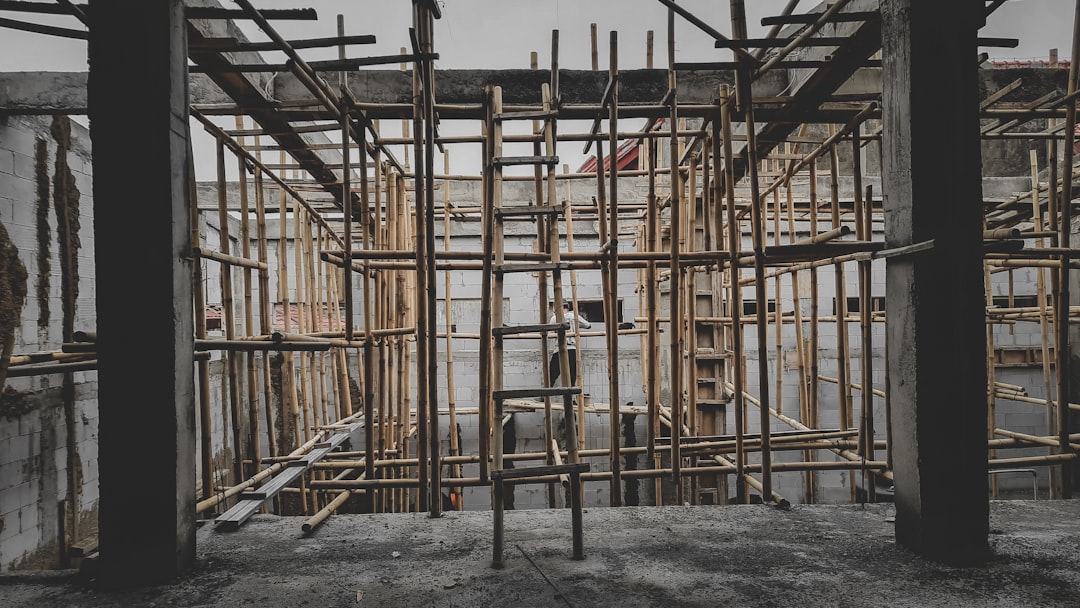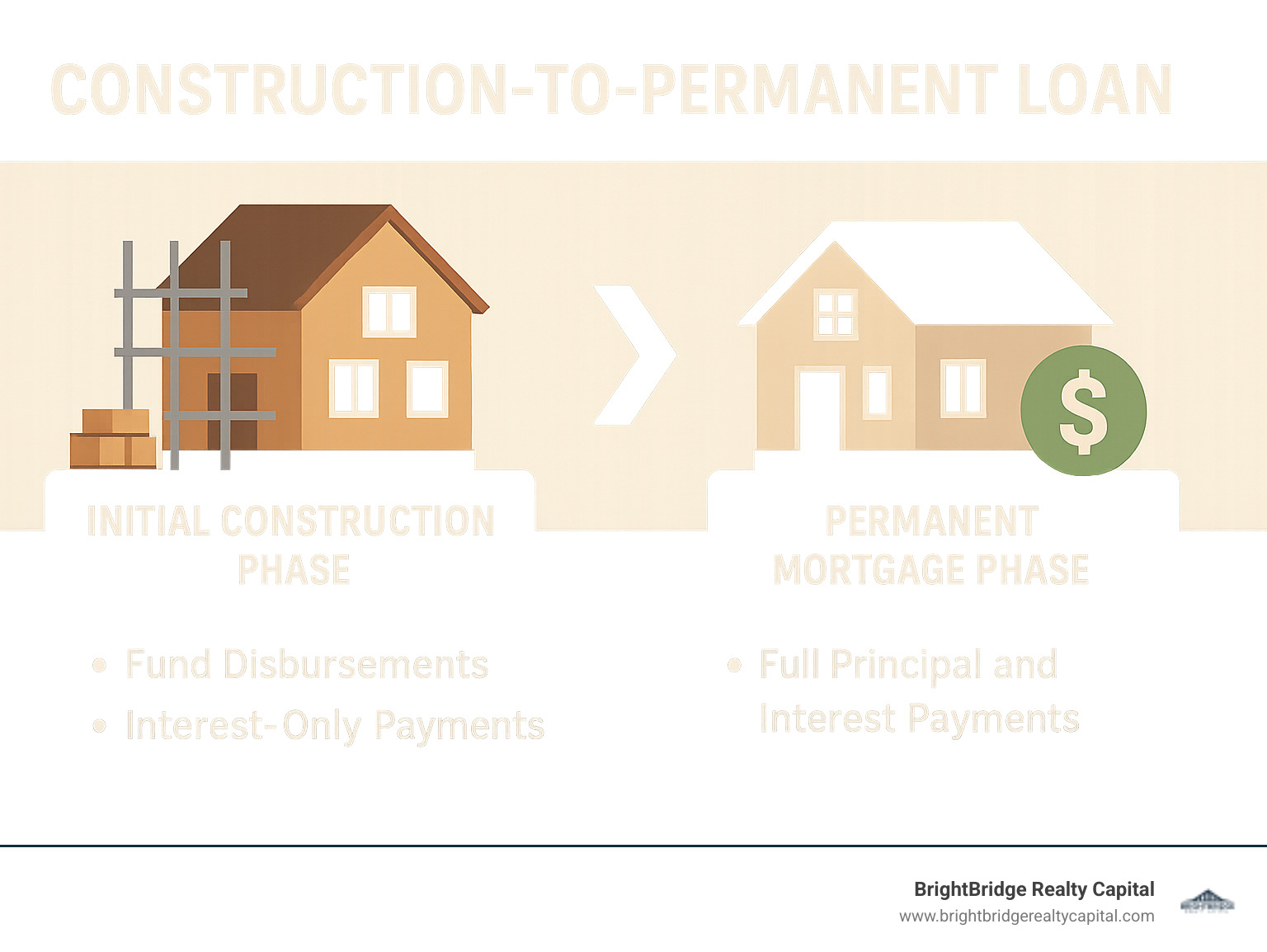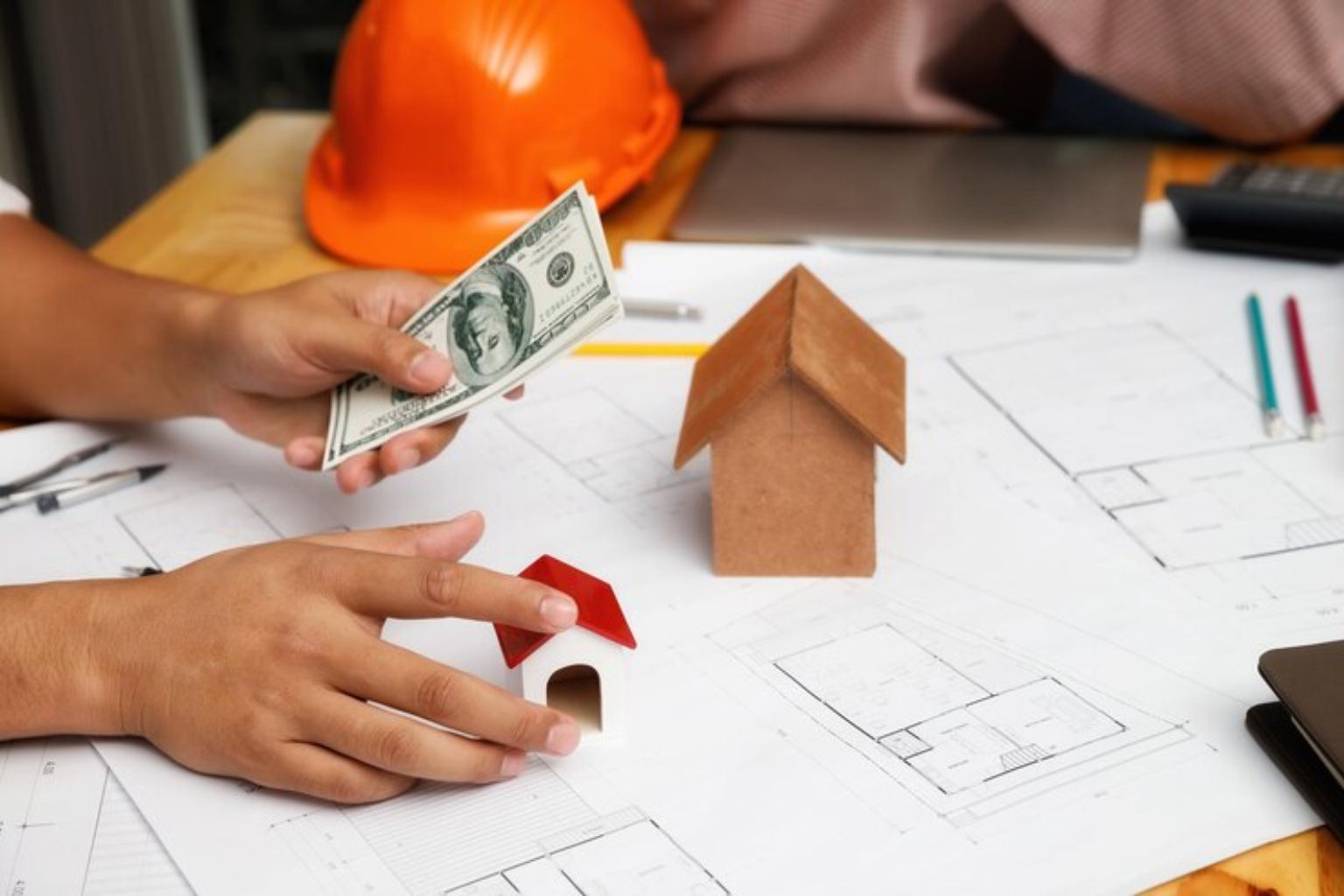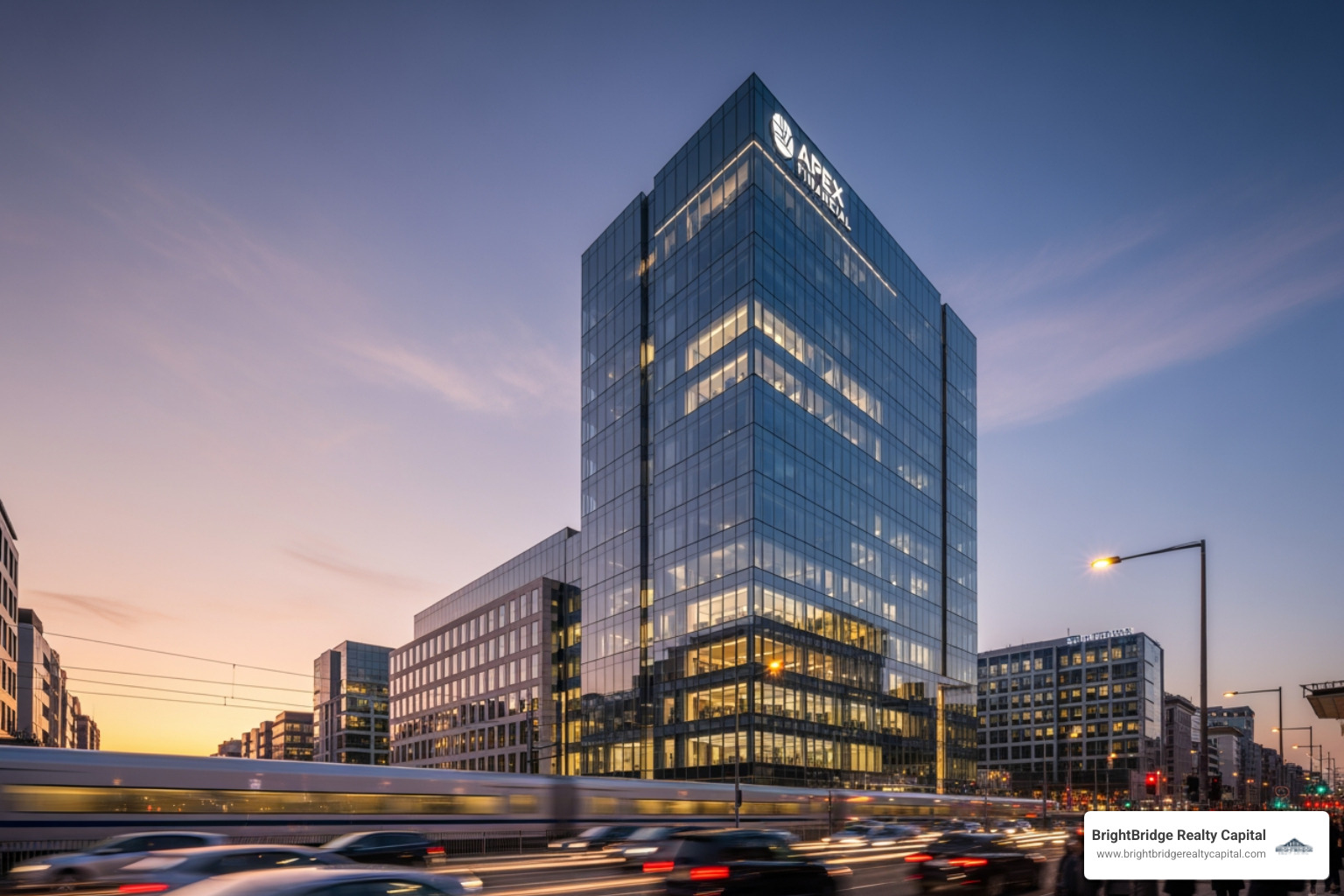Build and Settle: The Smart Way with Construction-to-Permanent Financing

What is a Construction-to-Permanent Loan?
Building your dream home or a new investment property can feel overwhelming, especially when it comes to financing. A construction to permanent loan simplifies this complex process, offering a single, streamlined solution for your new build.
Here's a quick look at what it is and how it works:
- One Loan, Two Phases: This unique loan combines the financing for your home's construction with your long-term mortgage into a single product.
- Single Closing: Unlike traditional methods that require two separate loans and two closings, a construction-to-permanent loan means you only close once, saving you time and money on fees.
- Interest-Only During Construction: During the building phase, you typically only pay interest on the funds disbursed.
- Automatic Conversion: Once construction is complete, the loan seamlessly converts into a traditional permanent mortgage (like a 15 or 30-year fixed-rate loan) without needing a second application or closing.
As Daniel Lopez, a loan officer at BrightBridge Realty Capital, I specialize in guiding borrowers through complex financing structures, including the nuances of construction to permanent loan products. My goal is to simplify these processes, helping real estate investors like you secure the financing needed for successful projects.

Key terms for construction to permanent loan:
The Ins and Outs of a Construction to Permanent Loan
A construction to permanent loan is truly a marvel of modern financing, cleverly packaging what used to be two separate, often complicated, financial journeys into one smooth ride. We call it a "two-phase process" because it distinctly divides into the period of building and the period of living, all under a single loan agreement. Think of it as having your cake and eating it too, but with blueprints and a Certificate of Occupancy.
During the initial "construction phase," the loan functions much like a line of credit. Funds are released incrementally as your project progresses. And here's where the magic (and savings) happens: you typically only make interest-only payments on the funds that have actually been disbursed. This keeps your monthly costs lower while your dream home is taking shape. Once the final nail is hammered and the last coat of paint dries, the loan seamlessly transitions into its "permanent phase." At this point, your payments switch to the traditional principal and interest structure, just like a standard mortgage. This "loan conversion" is automatic, meaning no second closing, no additional closing costs, and no re-qualifying for a new loan.
The typical timeline for this entire journey can vary. The construction phase itself generally lasts about one year, though we've seen it range anywhere from a swift six months to a more extensive 18 months, depending on the project's complexity and any unexpected hiccups (because, let's be honest, building can sometimes feel like a comedic play with unexpected plot twists!). Once your home is complete and the loan converts, the permanent mortgage phase typically settles into familiar terms, ranging from 10 to 30 years, giving you plenty of time to pay off your investment.
The Construction Phase: Building Your Vision
This is where your architectural dreams begin to solidify into brick and mortar. The construction phase is carefully managed through a "draw schedule." This isn't just a fancy term; it's a pre-agreed plan that dictates when and how funds are disbursed to your builder. As specific milestones are met – for example, the foundation is poured, the framing is up, or the roof is on – your builder will request a "draw."
Before funds are released, the lender will typically send an inspector to verify that the work has been completed to satisfaction. This ensures that the money is being used as intended and that your project is progressing according to plan. Once approved, the "fund disbursement" happens, and your builder gets paid. The good news for you? These "builder payments" are generally released swiftly, often within 2-3 business days of a draw request, keeping your project humming along.
As we mentioned, during this phase, you'll generally make "interest-only payments" based on the amount of loan funds that have been disbursed so far. This means your payments start small and gradually increase as more money is drawn, making the building process more financially manageable. We also strongly recommend allocating "contingency reserves" – typically limited to about 10% of the cost of construction – to cover any unforeseen expenses or delightful surprises that might pop up during the build. This way, you're prepared for the unexpected without derailing your budget.
Want to dive deeper into how we facilitate bringing new construction projects to life? Learn More on financing new builds with us.
The Permanent Phase: Settling Into Your Home
Once the construction phase is successfully completed, your construction to permanent loan undergoes an "automatic conversion." This is truly one of the most remarkable benefits of this loan type: there’s "no re-qualification" needed. You don't have to go through the application process again, provide new documents, or worry about your credit score changing. The loan simply transitions from a construction loan into a standard, long-term mortgage.
This typically converts into a "fixed-rate mortgage," giving you the stability of consistent monthly payments for the life of the loan. The "amortization" schedule begins, meaning you start paying down both principal and interest, chipping away at the loan balance with each payment. These "standard mortgage terms" usually range from 10 to 30 years, allowing you to choose a repayment plan that best fits your financial goals.
Before the conversion is finalized and you can truly settle into your new abode, a "final inspection" will be conducted. Upon successful completion, a "certificate of occupancy" will be issued. This crucial document signifies that your new home meets all local building codes and is safe and ready for you to move in. It's the official green light to start enjoying the fruits of your labor and financing!
Qualifying for Your Dream Build: Eligibility and Application

When you dream of building a brand new home, you're not just creating a place to live; you're creating an asset that doesn't quite exist yet! This makes financing a bit different from buying an existing house. Lenders tend to be a bit more cautious because the "collateral" – your beautiful, finished home – is still just a plan on paper. This means there are often stricter requirements for a construction to permanent loan compared to a regular mortgage. We get it; it might sound a little intimidating, but it's all about managing lender risk and making sure your dream project has the best chance to succeed.
The application process for a construction to permanent loan is similar to a standard mortgage application in many ways, but with a few extra layers. We'll still look at your overall financial health, but we'll also dive deep into your proposed project and the team you've chosen to bring it to life. This means reviewing extensive documentation about your plans and, very importantly, a thorough builder vetting process. After all, a skilled and reliable builder is the cornerstone of any successful construction project, and we want to ensure you're working with the very best.
What are the requirements for a construction to permanent loan?
To qualify for a construction to permanent loan, you'll generally need to show you have a strong financial foundation. Here’s what we typically look for:
First, your credit score is a big indicator of your financial reliability. Most lenders will look for at least a 680, with some even preferring 700 or above. However, if you're exploring government-backed options, it’s good to know that FHA loans may have lower requirements, sometimes as low as 580-620. This can open doors to homeownership for more people!
Next, be ready for a slightly larger upfront investment. Conventional construction to permanent loans typically ask for a down payment of 20 percent. Some lenders might even ask for up to 25% or 30%, especially for bigger or more complex projects. But don't worry, there are options! FHA One-Time Close Construction Loans can allow for a minimum down payment of just 3.5 percent, and for eligible borrowers in rural areas, USDA loans might even require no down payment at all.
We'll also look at your debt-to-income ratio (DTI). This number shows how much of your gross monthly income goes towards debt payments. It's a key way we understand your ability to comfortably manage new debt. For approval, we usually look for a DTI below 45%, though some programs can allow up to 50 percent. And finally, lenders often like to see that you have additional cash reserves on hand after closing. This shows you have a financial cushion for any unexpected expenses, which can be super helpful during a construction project. Just like with any mortgage, we'll need solid proof of income – usually W-2s, pay stubs, and tax returns – to make sure you can easily make your monthly payments.
It’s always a good idea to do your homework on any loan originator you work with. You can easily Check your loan originator's status here for added peace of mind.
The Application and Documentation Checklist
Getting all your ducks in a row for a construction to permanent loan means gathering some specific paperwork beyond what you'd typically need for a standard home purchase. It's like preparing a comprehensive story about your dream home! You'll need a signed builder contract, which is the formal agreement outlining the scope of work, timeline, and cost. This is the financial blueprint of your project. Then, there are the detailed construction plans (blueprints) themselves – these aren't just pretty pictures; they're the technical drawings of your new home. Lenders use these to truly understand the scope, design, and estimated value of your finished property. Some in the industry even affectionately call this your project's "blue book" – a comprehensive guide to everything being built.
You'll also need a meticulous cost breakdown and budget, detailing all anticipated expenses, from materials and labor to permits and contingency funds. This helps ensure the project is financially feasible. If you already own the land, you'll need land ownership documents; if you're purchasing it as part of the loan, the purchase agreement will be required. And of course, you'll need all the standard mortgage application paperwork – the usual suspects like income verification (pay stubs, W-2s, tax returns), asset statements (bank accounts, investment accounts), your credit reports, and personal identification. Gathering these items upfront can help make your application process as smooth as possible!
Construction-to-Permanent vs. Construction-Only Loans
It's easy to get a little lost in all the financing terms, right? Especially when you're looking at building your own place. But understanding the main difference between a construction to permanent loan and a construction-only loan is super important. While both help you get your new home built, they lead to very different journeys down the road.
Think of a construction-only loan as a short-term solution. It's just there to cover the costs of building your home. Once your house is finished, this loan needs to be paid off. That means you then have to go out and get another loan – a separate, traditional mortgage – to pay off the first one. It's like buying a car and then immediately having to buy a second car just to drive the first one home. A bit of a hassle, with two separate loan applications, two rounds of paperwork, and two sets of closing costs. Phew!
The Single-Closing Advantage
Now, this is where the construction to permanent loan truly shines! It offers a distinct "single-closing advantage" that makes life so much simpler. Imagine the relief of knowing you're set from the very beginning.
First off, you only pay one set of closing costs. This is a huge money-saver! Instead of forking out fees twice (once for the construction loan, and again for the permanent mortgage), you do it just once. This can really add up to significant savings right off the bat, keeping more money in your pocket for those finishing touches.
Then there's the fantastic benefit of a locked-in interest rate. With a construction-to-permanent loan, you get to secure your permanent mortgage interest rate before construction even begins. This protects you beautifully from any unexpected jumps in interest rates while your home is being built. You get peace of mind knowing exactly what your future monthly payments will look like. Plus, you'll enjoy simplified paperwork. You go through the application and closing process just once, instead of repeating it all. Less paperwork means less stress for you. All of this adds up to incredible peace of mind. Knowing your long-term financing is secured from day one lets you focus on the fun part: watching your dream home come to life, instead of juggling multiple loan applications.
As we've highlighted, construction-to-permanent loans have two phases, but here's the crucial part: you only close once!
Potential Disadvantages and Challenges
Now, while we're big fans of the construction to permanent loan and all its benefits, it's also important to be totally upfront about some of the potential drawbacks and "challenges" you might face. No financial product is perfect for absolutely everyone, and being prepared is key!
One thing to note is that these loans can sometimes come with higher interest rates compared to a standard mortgage for an existing home. Why? Well, lenders see construction projects as a bit riskier because the collateral (your beautiful, finished home) doesn't fully exist yet. The interest rate during the construction phase might even be a little higher than the permanent mortgage rate that kicks in later. You'll also typically need larger down payments – often 20% or more. This can be a significant upfront financial commitment, so it's something to budget for.
Another challenge can be finding a lender who offers these types of loans. Not every financial institution specializes in construction to permanent loans. They require specific expertise and a willingness to handle the unique risks involved. That's why finding the right lending partner is so important.
Also, let's be real: project delays can happen in construction. Unexpected weather, material shortages, or even labor issues can push timelines back. While your loan usually has a "time limit for building the home" (often around a year, sometimes with extensions), these delays can add stress and potentially even more interest costs. And speaking of costs, there's always a risk of cost overruns. Even with careful planning, unexpected expenses can pop up. If your project goes over budget, you generally cannot increase the loan amount. This means you'd have to find other ways to cover the difference or pay out-of-pocket. This is exactly why we always stress the importance of having those contingency reserves!
Finally, lenders often require you to work with a strict lender-approved builder. This is a safeguard to protect everyone, ensuring your project is in capable hands. It means you can't just pick any contractor; they need to meet specific criteria, like being licensed, professional, and having a proven track record. It's all about making sure your dream home gets built right!
Understanding the Financials: Loan Types and Covered Costs
Navigating the financial landscape of a new build involves understanding what your construction to permanent loan proceeds can cover, and how to budget effectively to keep your project on track. This loan is designed to fund the various "project costs" associated with bringing a new structure to life.
What a Construction-to-Permanent Loan Typically Covers
The beauty of a construction to permanent loan is its comprehensive nature. It’s designed to wrap up most of the significant expenses involved in building your home or investment property. Here’s a list of what’s typically covered:
- Land Acquisition: If you don't already own the plot, the loan can often include the "cost of land" itself. This means you can finance the land purchase and the construction all in one go.
- Labor and Materials: This is the core of your build. The loan provides funds for all the "materials" (lumber, concrete, wiring, plumbing, finishes, etc.) and the "labor" involved in putting it all together, from the foundation crew to the painters.
- Permits and Fees: Construction involves a labyrinth of "permits and fees" from local authorities. Your loan can cover these necessary bureaucratic costs.
- Architect and Engineering Fees: The creative minds behind your design and the technical experts ensuring its structural integrity – their fees are typically included.
- Landscaping: Often, basic "landscaping" to finish the exterior of your property can be rolled into the loan.
- Contingency Funds: As mentioned, a portion of the loan can be set aside as "contingency funds" (usually around 10%) to absorb unexpected costs during construction without derailing your budget.
What’s typically not covered are things like furniture, decor, or anything not directly related to the physical construction of the home.
What types of construction to permanent loan are available?
Just like traditional mortgages, construction to permanent loans come in a few different flavors to suit various needs and borrower profiles:
- Conventional Loans: These are the most common type, offered by private lenders. They typically require higher credit scores and down payments (20% or more) but offer more flexibility in terms of loan amounts and property types.
- Government-backed Loans: These are fantastic options, especially for first-time homebuyers or those with lower down payments.
- FHA One-Time Close: Backed by the Federal Housing Administration, these loans are popular for their lenient credit requirements (as low as 580-620) and a minimum down payment of just 3.5 percent. They're a great option for building a primary residence.
- USDA Single-Close loans: For eligible borrowers in designated rural areas, the U.S. Department of Agriculture offers "no down payment" options, making home construction incredibly accessible. You can learn more about USDA Single-Close loans directly from the source.
- VA Construction Loans: A tremendous benefit for eligible veterans, service members, and their surviving spouses, these loans often require no down payment and offer competitive interest rates.
- Manufactured Home Financing: Yes, "manufactured homes are eligible for both one-close and two-close construction-to-permanent transactions" under Fannie Mae guidelines. It's worth noting that while detached condo units are eligible, "only detached condo units are eligible for construction-to-permanent financing; other condos and co-ops are ineligible." For more details on this, you can review the Fannie Mae manufactured home guidelines.
Frequently Asked Questions about Construction-to-Permanent Loans
We know that building a home comes with a lot of questions. Here are some of the most common ones we hear about construction to permanent loans:
Can I act as my own builder with this type of loan?
We hear this one a lot! Many folks dream of building their own home, especially if they have a knack for DIY or some construction smarts. For a construction to permanent loan, lenders usually want you to work with a licensed, experienced, and lender-approved builder. Why? Well, when you're building from scratch, there's more increased lender risk. The home isn't quite there yet, right? So, lenders really depend on your builder's good name and financial strength to make sure the project gets done right.
Now, can you be your own owner-builder? It's not totally out of the question, but it comes with some higher requirements. You'd need to show lots of proven experience managing building projects. Maybe you even have a contractor's license yourself! You might also need to put down a bigger down payment or have more cash saved up. Some lenders might even charge higher rates because of the extra risk involved. For most people, it's a lot smoother to team up with a trusted, third-party builder to get this type of financing.
What happens if construction costs more than the loan amount?
Oh, the famous "cost overruns"! Even with the best plans, sometimes building a home can throw you a curveball and cost a bit more than expected. If your construction costs more than the loan amount, you generally have a few ways to handle it. But here's the main thing to remember: lenders usually don't let you just increase your construction to permanent loan once it's finalized.
This is exactly why we always talk about those contingency reserves! Think of them as your project's rainy day fund, usually about 10% of your total construction cost. They're your first line of defense for those small, unexpected bumps. For bigger surprises, you'd be responsible for paying the difference with out-of-pocket expenses. This might mean dipping into your savings, getting a personal loan, or finding other ways to cover the extra costs. It's a tough situation, which really highlights the importance of fixed-price contracts with your builder and having a super realistic budget from the very start. On the flip side, if your project comes in under budget, any extra loan money usually goes back to the lender, which helps lower your loan principal.
Can I refinance a construction-to-permanent loan?
Great news here: Yes, you absolutely can refinance your construction to permanent loan! Once your loan smoothly transitions into its permanent mortgage phase, it acts just like any other standard home loan.
So, why might you want to refinance? Maybe interest rates drop a lot after your beautiful home is finished. Refinancing could help you grab a lower interest rate and shrink your monthly payments. Or, perhaps you're thinking about changing loan terms. You might want to switch from a 30-year mortgage to a 15-year one to pay off your home faster. The whole process would follow the standard refinance process. This means a new application, a fresh look at your credit, an appraisal of your home, and another closing. It's just like refinancing any other home loan you might have.
Your Partner in Building and Investing
The journey from a blank canvas to a finished home or a thriving investment property is an exciting trip! And as we've explored, a construction to permanent loan truly stands out as a smart, efficient solution to help you get there. Imagine the relief of a single closing, saving you time, hassle, and those extra fees. Picture the peace of mind that comes with a locked-in interest rate, shielding you from unexpected market shifts. This isn't just about financing; it's about a simplified process that allows you to focus on the exciting parts of building, rather than getting tangled in financial red tape.
For real estate investors, especially those seeking fast and flexible funding for new construction projects, working with a direct lender is absolutely key. We understand that in the world of real estate, speed and efficiency aren't just nice-to-haves – they're essential.
At BrightBridge Realty Capital, we pride ourselves on being that trusted partner. We offer customized real estate financing solutions nationwide, specializing in quick, flexible funding specifically designed for real estate investors like you. Our unique approach means fast closings, often within just a week, and direct lending without intermediaries. This translates into competitive rates and a truly seamless process, all from our New York, NY office. We're not just providing a loan; we're helping you lay the foundation for your next successful venture.
Ready to turn your construction dreams into a tangible reality? Don't wait. Explore Ground-Up Construction Loans with BrightBridge Realty Capital today.


